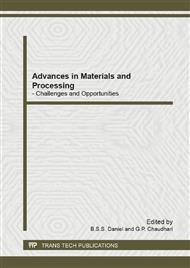p.425
p.430
p.435
p.440
p.445
p.450
p.455
p.460
p.465
Heat-Treatment Studies on Dissimilar Ti-Alloy EB Weld Joints
Abstract:
Ti3Al2.5V alloy is lean alpha plus beta titanium alloy having two phase microstructure at room temperature (RT) and has beta transus temperature (Tβ) about 9350C and Ti6Al4V-ELI (extra low interstitials) alloy has two phase structure at RT and has Tβ about 9750C. The samples were electron beam welded (EBW) after the optimization of weld parameters on bead-on plate of 6mm thickness of Ti6Al4V-ELI alloy. The samples were heat treated (solution treated, ST at 9100C for 20 minutes water quenched, WQ and aged at 5100C for 8 hours and air cooled, AC to RT). The specimens were tested to evaluate mechanical properties in as-welded, solution treated and aged conditions. The improvement in the tensile strength was 810 MPa to 897 MPa in as weld to ST conditions, and comparable in STA condition (887 MPa). The improvement in yield strength was 760 MPa to 782 MPa and 848 MPa in as-welded, ST and aged conditions respectively. While there is a decreasing trend in the ductility (%EL) of the joint in three conditions (as weld, ST and STA). In all the specimens evaluated at different heat treated conditions the failure location was within parent Ti3Al2.5V alloy (parent metal away from the weld interface) as confirmed through OM (optical microscopy).
Info:
Periodical:
Pages:
445-449
Citation:
Online since:
November 2012
Price:
Сopyright:
© 2012 Trans Tech Publications Ltd. All Rights Reserved
Share:
Citation:


